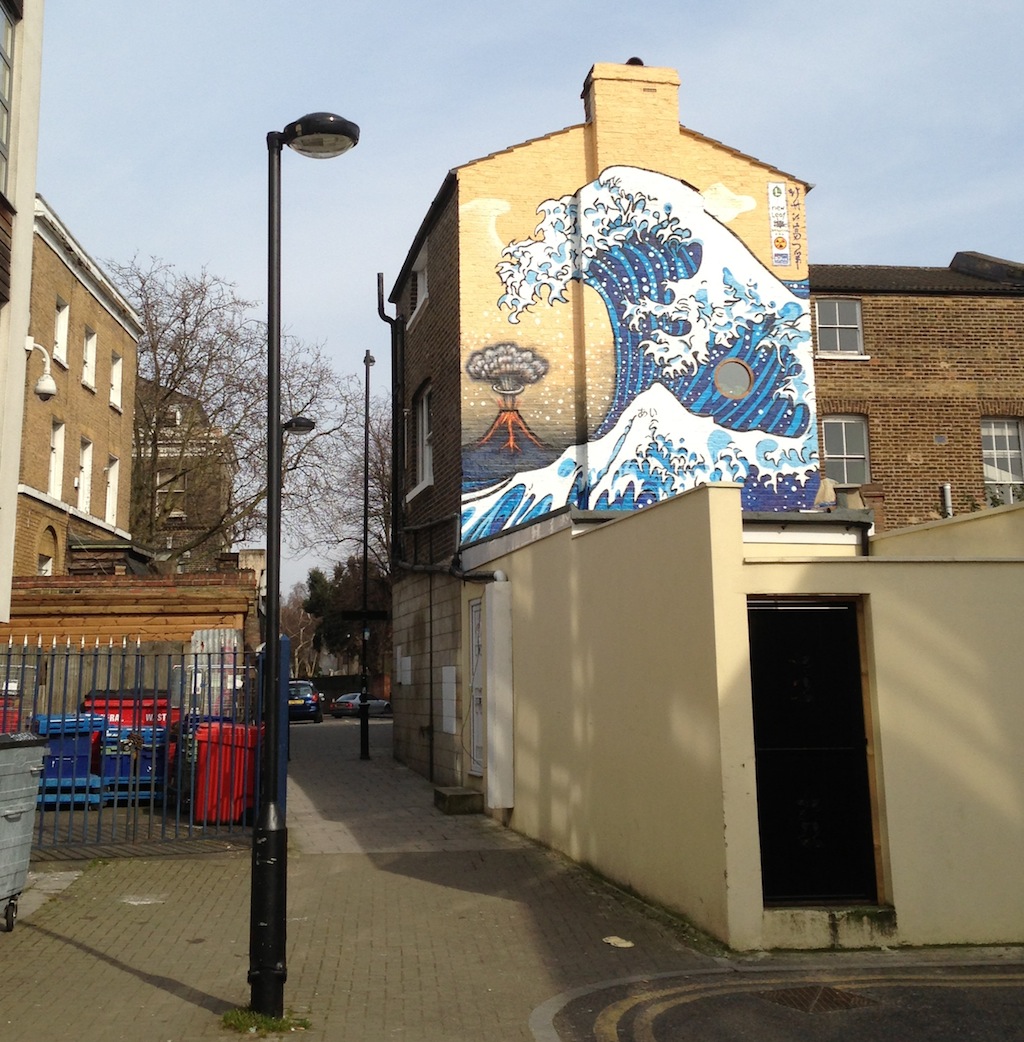

For 15 years, a giant tsunami has loomed threateningly – and colourfully – over Camberwell Place, SE5, the little alleyway that runs between Coldharbour Lane and Denmark Hill.
These days, close observers may notice that the mural is now also adorned with a small corporate logo and an additional detail added to the background (which you can see above, on the left of the painting as it looks now, but not in the painting as it looked a couple of years ago, left). But we’ll come back to that.
Designed deliberately to appear as if it is crashing down onto the passage, the huge mural of a wave – a reversed replica of the Japanese artist Katsushika Hokusai’s 1831 wood block print, Under the Wave, off Kanagawa (the original of which is in the British Museum) – first appeared in 1998. It was a commission as part of the fourth ever Camberwell Arts Festival. And the artist who painted it, Dominic Swords, still lives in the house whose side-wall it adorns.
But a year ago this month it looked as if the mural might be no more. The garage at the back of the building (whose complementary cerulean blue door locals may recall), was virtually destroyed by a fire in April 2012, and five fire engines and 30 firefighters were called to the scene. Rumours that the blaze was due to an explosion from a Breaking Bad-esque drugs factory inside turned out to be true.
A man seen jumping from the window of the building to escape the fire was 42-year-old Spaniard, Miguel Carmona Gutierrez. Gutierrez, it transpired, had been stirring together chemicals to make cocaine at the time of the explosion. He was severely burned and had to stay in a specialist burns unit for a couple of months before police were able to arrest him. He has since been sentenced to six years in prison – though not before he went on the run to evade his court appearance, trying to flee the country.
“This case highlights the dangers involved in the production of controlled drugs,” said the Police in a brilliant quote at the time of his conviction. “CCTV showed the doors of the property blown off by the explosion moments after someone walked past. It is extremely fortunate that no one else was seriously injured. Gutierrez is lucky to have his life, we hope,” the concluded, “that he uses the time in prison to reflect and re-habilitate his lifestyle.”

Hmm. But – back to the painting. Along with half of the ground floor of the building, much of the beautiful mural above was also damaged. Fans of the artwork – including the London Mural Preservation Society (LMPS) – despaired that the Wave was lost forever. So the Society got together with Vinnie O’Connell, who runs the New Leaf community project (which spearheaded the restoration of Brixton’s famous windmill). O’Connell set up a Facebook page campaign to recruit volunteers to help repair the painting, including two local artists who undertook much of the work.
 mORGANICo, whose street art pieces such as Devil No. 2 (right) you can see at Saatchi’s online store and gallery and Solo One, originally from Bristol, did the bulk of the graft. And, along with the LMPS, they made a key creative decision, as the Society’s Ruth Miller explains: “It was thought appropriate to do an explosion coming from Mount Fuji to mark the damage done by the explosion of 2012. It also echoes the shape of the nuclear cloud in local Brixton mural Nuclear Dawn and reminds us of the Fukushima Daiichi nuclear power plant disaster, which came after the 2011 Japanese Tsunami.” So now you can see the erupting volcano in the background of the painting, which wasn’t part of Dominic Swords’ original.
mORGANICo, whose street art pieces such as Devil No. 2 (right) you can see at Saatchi’s online store and gallery and Solo One, originally from Bristol, did the bulk of the graft. And, along with the LMPS, they made a key creative decision, as the Society’s Ruth Miller explains: “It was thought appropriate to do an explosion coming from Mount Fuji to mark the damage done by the explosion of 2012. It also echoes the shape of the nuclear cloud in local Brixton mural Nuclear Dawn and reminds us of the Fukushima Daiichi nuclear power plant disaster, which came after the 2011 Japanese Tsunami.” So now you can see the erupting volcano in the background of the painting, which wasn’t part of Dominic Swords’ original.
The other addition is a logo from Dulux. And it’s not just gratuitous branding: the company, in fact, supplied all the paint for the project as part of their rather lovely Let’s Colour project. Isn’t it great when big brands siphon off some of their profits to fund good causes? And Let’s Colour, not unlike that of our friends in Loughborough Junction, but on a global scale, is about: “Transforming grey spaces all over the world, from Brazil to France, to India and beyond with the aim of positively impacting the daily lives of the people in the surrounding area.” The interesting initiative launched in 2012 and has committed to liberate more than 60,000 litres of its paint to neighbourhood spaces across the UK.
Anyone else got some suggestions for where in south London we could use it?
Words: Kate Burt Images (main): Holly Atkins
Sources: Global Street Art; London Mural Preservation Society; Morganico; Solo One; Dulux; Metropolitain Police; British Museum. With special thanks to Holly Atkins for spotting the Dulux logo and sparking this story. Seen something interesting? Snap it and send us the details – and we’ll do the rest: info@belowthereiver.co.uk



